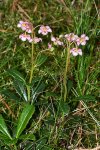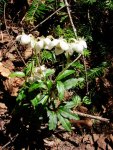Winter salmon - chimaphila r.
Family Heather - Ericaceae
Botanical characteristics. Shrub with creeping rhizome.
Leaves are evergreen. Flowers pink, regular, bisexual, five-dimensional, on long pedicels, in umbellate end brushes or scute. Fruit is a box. Blooms in June, fructifies in August.
There are two types:
- Zymolyubka umbellate - Ch. Umbellata L. It grows on dry soils in coniferous and mixed forests. Stems 10-40 cm high, wintering, underground. The leaves are almost verticillate, oblong-otklyklinovidnye, sharply serrate, leathery, thick, concentrated below the stems. The flowers are collected in the scutellum. Fruit flattened globular.
- Japanese gingerbread hat - Ch. Japonica M. It grows in groups on mountain slopes in forests. Stems 5-12 cm tall, wintering, aboveground. Leaves opposite or closely approximated, lanceolate or oval, pointed, serrate. The fruit is spherical.
Both species are similar in chemical composition, have similar healing properties, are used in medicine.
Used parts of the plant. Medicinal raw materials are leaves, flowers, seeds, rarely roots. Raw materials are collected during the whole vegetation period of the plant. Dry at a temperature of no higher than 50 ° C.
Chemical composition. All parts of the plant contain triterpenoids (taraxerol, ursolic acid, armies and isomers thereof), steroids (sitosterol), phonols and their derivatives; Tannins, flavonoids (quercetin, aviculary, hyperin), higher aliphatic hydrocarbons, vitamins, microelements.
Application. In folk medicine, decoctions and infusions of the above-ground part of the wintergreen are used for pyelitis, cystitis, enterocolitis, kidney and heart diseases such as laxative, diuretic, anti-inflammatory, rheumatism, gout, scrofululosis, prostatitis, liver diseases, jaundice, diabetes, diarrhea, stomach cancer, Epilepsy, hernia in children, hematuria, with metro- and menorrhagia, urolithiasis. In homeopathy, the juice of a flowering plant is widely used for various diseases of the internal organs, mainly in diseases of the kidneys and urinary tract.
In foreign literature, there are reports that the preparations of wintergreen are used in the treatment of malignant tumors. In this regard, interest in the plant increases, it is recommended for further study, introduction to culture. Some authors note that plants in culture have the greatest healing properties.
Preparation. For broth take 20 g of leaves, flowers or seeds, grind, pour 200 ml of boiling water, insist on a boiling bath for 30 minutes, cool, filter. Take 2 tbsp. Spoon 3 times a day.




Comments
Commenting on, remember that the content and tone of your message can hurt the feelings of real people, show respect and tolerance to your interlocutors even if you do not share their opinion, your behavior in the conditions of freedom of expression and anonymity provided by the Internet, changes Not only virtual, but also the real world. All comments are hidden from the index, spam is controlled.